The 35 Best Movies about Witches
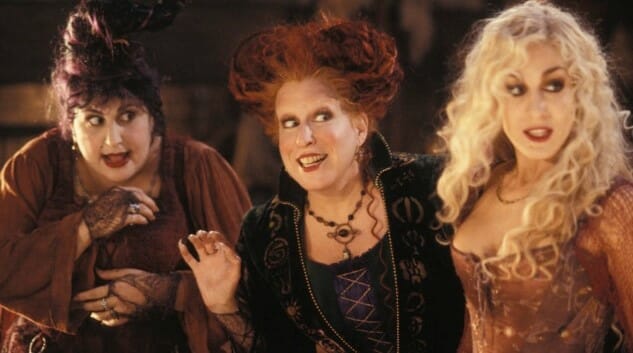
When we consider the concept of witches in movies, we tend to first fall back on the old bits of iconography. Pointed hats and warty chins. Malicious old crones, twisted and deformed by a lifetime (or several lifetimes) of practicing the dark arts. Flying broomsticks and children in cages, waiting for the oven to adequately preheat. You know, standard witch stuff.
But the depiction of witches really isn’t quite so simple as all that. For one thing, they’re not always malevolent forces in cinema. Nor are they all ancient and withered. Or even women, for that matter. The modern witch, in fact, can be whatever the story requires her (or him) to be. Witches can be protagonists, or comic relief. They can start delivery services or repel the Nazis from England’s shore (provided they’re also Angela Lansbury—more on that below). They can star at the heart of multi-billion dollar box franchises, or go back to their roots to give us some of the best of modern, indie horror. Witches can do it all.
Note: There are necessarily some spoilers for certain films on this list, especially if the “witch” component is itself some sort of twist.
So with that said, let’s count off the 35 best witch movies.
35. Maleficent (2014)
Director: Robert Stromberg

What little curiosity value Maleficent provides arrives mostly in the extravagant visual design. It’s not a patch on the landmark work in Disney’s Sleeping Beauty—still one of the most striking animated films ever made—but something to behold nevertheless. Consider it both a strength and a weakness that Stromberg clearly put so much effort into the film’s visual design (largely, it seems, at the expense of story), and his top-notch collaborators include makeup whiz Rick Baker (who designed Angelina Jolie’s witchy nose, horns and severe cheekbones), costume designer Anna B. Sheppard and production designers Gary Freeman and Dylan Cole. Their efforts vividly bring the fairy tale settings to life, updating one of Disney’s original witchy antagonists for the modern age. —Geoff Berkshire
34. I Married a Witch (1942)
Director: René Clair
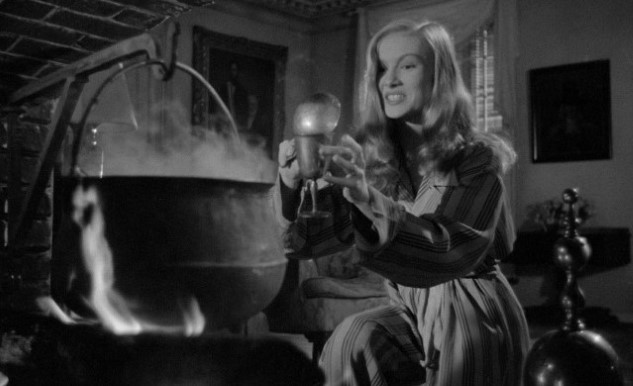
You can thank the Criterion Collection for reviving modern interest in this curious, noir-tinged little comedy, which had largely been washed away into obscurity despite the presence of stars Fredric March and Veronica Lake. Amusingly, the synopsis hardly sounds like a comedy at all: The film revolves around a witch and her father who were executed in colonial America for practicing the dark arts, only to be resurrected in the 1940s, where they hound the descendent of the man responsible for their deaths. As in the later Bell, Book & Candle, the farcical use of magic is played for laughs but is oddly sinister at the same time—it is first used to nudge a man into infidelity, and later to encourage voter fraud in an election. Regardless, you’re watching it today to see ’40s bombshell Veronica Lake at the height of her powers, looking effortlessly glamorous in her signature peek-a-boo hairstyle a year after Sullivan’s Travels made her a household name. Despite the decidedly silly plot, Lake’s impeccable charm is hard to resist. —Jim Vorel
33. Practical Magic (1998)
Director: Griffin Dunne

The word “witch” doesn’t just describe the cackling, potion-brewing figure from folklore. It can also be a hateful epithet, leveled at any woman who rejects the scorn society levels at the girls who won’t stay quiet and pretty and demure. Practical Magic may go all over the map with the plot and tone in a story about Sandra Bullock and Nicole Kidman’s orphaned witch sisters and their struggles with life and romance, but that subtext of reclaiming your autonomy is there throughout the whole picture. Magic is strange and dangerous in untrained hands in Practical Magic, likely to result in unforeseen consequences if used selfishly. It’s also the way these sisters come to one another’s aid and banish the negativity from their lives. If your choices are being a good little girl or nuking the lingering spirit of your ex-boyfriend and literally sweeping his ashes out the front door while the ladies of the town cheer, then it’s not hard to see why some women choose to be witches. —Kenneth Lowe
32. Witchboard (2025)
Director: Chuck Russell

A quarter of a century after his last horror film, 2000’s critically reviled Bless the Child, it’s a pleasure to report that Chuck Russell’s reimagined Witchboard is relentlessly entertaining, nasty in its misanthropic delight in messing with its characters, stylishly put together, and unexpectedly sexy to boot. Deeply silly but more narratively ambitious than one would likely expect, it’s bursting (honestly overstuffed) with ideas and cinematic verve, taking advantage of a slightly longer runtime to really venture into increasingly bonkers metaphysical territory as it draws on and creates new cinematic tropes for movies about witches. As long as the viewer can roll with a little tonal drift, it’s easy to appreciate Russell’s still sharp sense of humor, his panache, and the deliciously arch performance of Stranger Things star Jamie Campbell Bower in particular, who brings the kind of gravitas to a villain performance that you might have expected to get out of Vincent Price in the 1970s or Jeffrey Coombs in the 1980s. Witchboard is unified by a wry sense of absurd humor and a loving appreciation for genre handiwork, enlivened by above-average technical production from Russell’s team. The spell it casts is more than strong enough for a rewardingly silly night at the movies. —Jim Vorel
31. Bell, Book & Candle (1958)
Director: Richard Quine
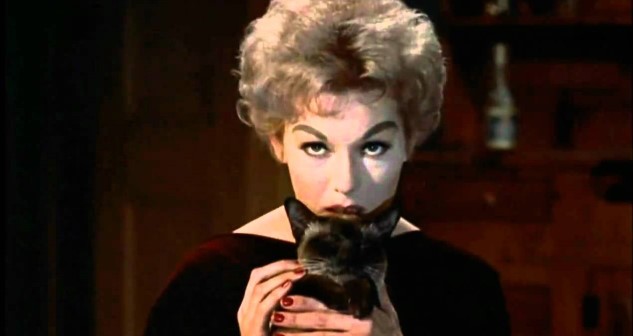
It’s strange to think that mere months after starring opposite each other in Hitchcock’s masterfully suspenseful Vertigo, Jimmy Stewart and Kim Novak were reunited for a romantic comedy about urban witches. Widely considered to be the last time Stewart played a true romantic lead in his career (he was 50 at the time), the film is instead dominated by the icily seductive Novak, playing a Bohemian witch-about-town who decides to muck about in Stewart’s love life, chiefly for petty revenge. Of course she falls for the much-older man along the way, leading to a choice between retaining her witchy powers or giving in to love. The whole thing is played as a chastely “sexy” farce, but it’s simultaneously the type of story you really wouldn’t be able to position as a light comedy today—the “love spells” and repeated threats of magical, forced seduction feel a bit strange to watch in the #MeToo era. Still, along with the previously mentioned I Married a Witch, Bell, Book & Candle managed to lay the groundwork for the “magical domesticity” genre you’d later see in Bewitched and I Dream of Genie. —Jim Vorel
30. Into the Woods (2014)
Director: Rob Marshall
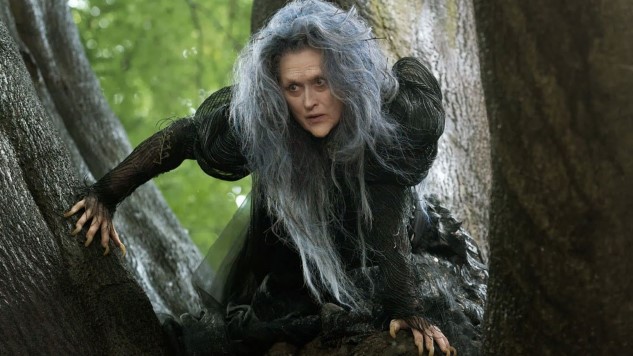
Film adaptations of beloved musicals are almost always polarizing; to succeed, the movie must simultaneously capture the magic of the stage while bringing something visually new to the proceedings. Movie stars take the parts of talented stage actors, sometimes to the detriment of the music. But the fantastical nature of Disney’s Into the Woods leads to a visual spectacle, and the cast—including James Corden, Emily Blunt, Meryl Streep, Johnny Depp, Anna Kendrick—does a fine job with the songs. Streep is especially enjoyable as the story’s vindictive witch. The real joy here is seeing a Disney fairytale that satirizes Disney fairytales, but with half an eye on its tween-set base, it’s never quite as wickedly dark as Stephen Sondheim’s original. Still, it’s a refreshing twist to see the princesses taking control of their own destinies, and the humor of princes just a little too in love with their own charm won’t be lost on even the youngest audiences. —Josh Jackson
29. Bedknobs and Broomsticks (1971)
Director: Robert Stevenson
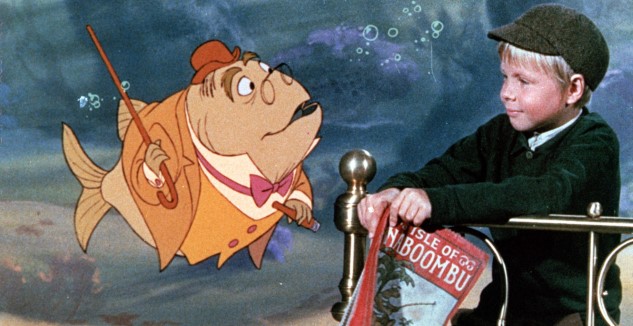
The easiest way to sum up Bedknobs and Broomsticks is basically to say it’s Mary Poppins, except on half the budget and double the LSD. What the folks at Disney were thinking when they conceived of a tale that involved witchcraft, hijinks and the Nazis invading England it’s impossible to say, but Angela Lansbury makes for a fine, matronly witch in training. Like Mary Poppins, the film can boast an animated interlude involving an island of anthropomorphized animals, their designs all suspiciously similar to Disney’s own Robin Hood, which would be released two years later in 1973. And did we mention this is all in service of finding a spell that Angela Lansbury can use to repel the Nazi invaders? Truly, the ’70s were a bizarre time for Disney. —Jim Vorel
28. The Chronicles of Narnia: The Lion, the Witch and the Wardrobe (2005)
Director: Andrew Adamson

The Lion, the Witch and the Wardrobe, more so than any of the watered down Narnia sequels that followed, did an admirable job of taking C.S. Lewis’ iconic series and interpreting its inspiring DNA to the screen, while leaving behind those elements the rank-and-file viewers would not necessarily care to consider—its Christian allegorical themes, most prominently. What we’re left with is to some degree a sanitized version of Narnia, but not in a way that has somehow been defiled—rather, it’s simply been broadened, simplified and made approachable for younger audiences. It’s certainly well cast—the Pevensie kids are the right blend of naive and likable, with the exception of the churlish Edmund; Liam Neeson is the lordly Aslan, who radiates power and gravitas; and Tilda Swinton could hardly be more icily menacing as Jadis, The White Witch. As it always has since the novel was first published in 1950, the film’s depiction of Jadis is chilling but seductive enough to make just about any kid wish they knew what Turkish Delight tastes like. —Jim Vorel
27. The Blair Witch Project (1999)
Directors: Eduardo Sánchez, Daniel Myrick
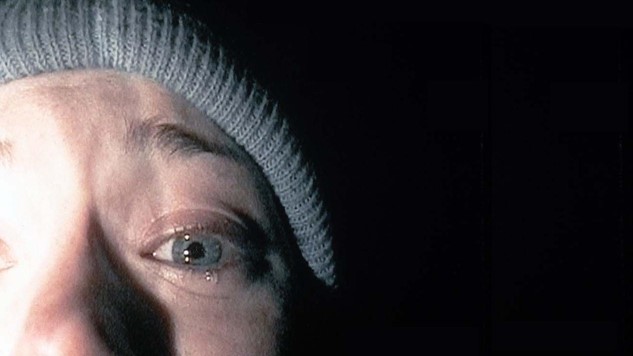
The titular “witch” in The Blair Witch Project, like so much else in the film, is ultimately whatever you want it to be. Unfairly derided in the years since its release, thanks to its part in launching the gimmick-laden found-footage sub-genre of modern horror, The Blair Witch Project was one of the ’90s greatest achievements in cinematic marketing. Taking advantage of the burgeoning internet era to spread rumors about the film’s origins and veracity, Blair Witch managed to convince otherwise normal people that they were sitting in a theater, watching a legitimate snuff film in wide distribution. The fact that it was never at all clear who (or what) “the witch” was, exactly, only heightened the sense of voyeuristic terror. All we knew is that there was something decidedly wrong about those woods, and the horror genre was never the same again. —Jim Vorel
26. Hellbender (2022)
Director: John Adams, Zelda Adams, Toby Poser
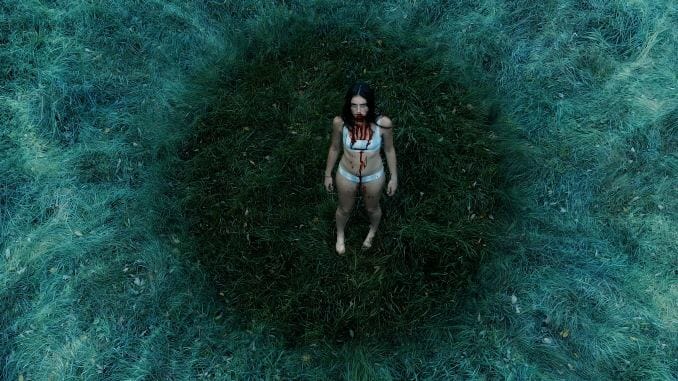
Over the course of their eight-year collective filmmaking practice, the Adams family have continuously honed their aesthetic and narrative interests as artists. With Hellbender, the sixth feature from the nuclear family of filmmakers, confidence and creativity converge to produce something that feels like an alchemic breakthrough. Particularly following their 2020 supernatural thriller The Deeper You Dig, it appears the Adams have acquired a penchant for horror—a perfect complement to their signature low-budget, home-grown style. Though Hellbender utilizes many recurring motifs present in the Adams family’s work—such as dysfunctional family dynamics and nods to John Adams’ former career as a punk musician—it is certainly the most (literally) fleshed-out project the family has undertaken to date. 16-year-old Izzy (Zelda Adams, the youngest daughter and fellow co-director of John Adams and Toby Poser) has been warned from a young age by her mother (Poser) that the outside world will cause her nothing but harm due to her rare autoimmune disease. As such, Izzy spends her days frustrated and friendless, with only the vast landscape surrounding her mother’s reclusive mountain home providing her with any semblance of personal enrichment. Despite being forbidden to leave the property, Zelda’s relationship with her mother is far from acrimonious—they are playfully affectionate with one another, cradling each other’s faces in their hands and venturing into the verdant forest for rainy day hikes. They even perform in a drum and bass punk rock band, appropriately named Hellbender, donning audacious face make-up and practicing tight, catchy songs for the sole benefit of themselves. Every facet of Hellbender has the intrinsically magical quality of being hand-helmed by a small faction of creatives that execute every stage necessary for the film’s production. The cinematography by Zelda and John is just as impressive as the laid-back yet quirky costume design by Poser. The end result is completely stunning in its scope, tandemly laser-focused on two individuals and their insular livelihood while exploring the vast terror of supernatural possession. By the time the film come to a gory, gloomy conclusion, the viewer walks away feeling thoroughly put through the wringer—inherited traumas, overbearing impositions and brooding bloodlust are never presented in a completely straightforward fashion, providing ample twists to accompany any revelation the film wishes to divulge. Tethered closely to the emotions and artistic sensibilities of the tight-knit family that created it, Hellbender is a can’t-miss foray into folk horror. Unabashedly creepy yet perplexingly comforting, it will inevitably remind audiences of the most eccentric aspects of our upbringings. At the same time, it will evoke deeply-concealed memories of the anguish of undergoing growing pains—a veritable hell on Earth if there ever was one.–Natalia Keogan
25. The Sword in the Stone (1963)
Director: Wolfgang Reitherman

It’s a bit of a shame that Disney animated features of this period—your Robin Hoods and Sword in the Stones—haven’t quite maintained their classic status, often being relegated to the depths of the infamous Disney “vault,” unknown to younger generations whose exposure began with The Little Mermaid and the following Disney Renaissance of the 1990s. This Arthurian adaptation, loosely based on The Once and Future King, isn’t free from rough patches, but it has charm in spades despite a voice cast without any major stars. One might almost consider it a Harry Potter precursor, with a story that involves Arthur being transformed into various animals to learn life lessons from his tutor, Merlin. It certainly merits inclusion on a list of cinematic witches for the self-aggrandizing “Mad” Madam Mim, who Merlin eventually duels in one of animation’s best contests of magical shape-shifting. Although really, transforming into a virus to steal a win seems like a pretty cheap move. —Jim Vorel
24. Stardust (2007)
Director: Matthew Vaughn
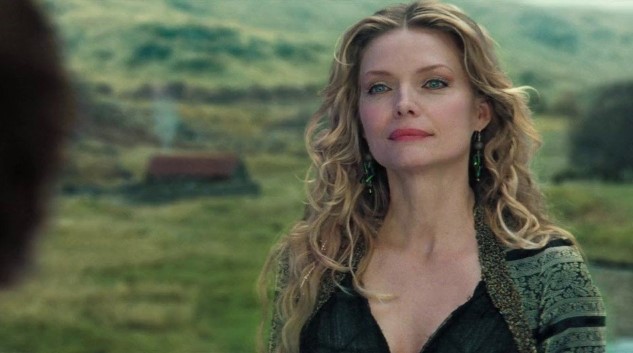
Only Neil Gaiman would write a setting where a steampunk-tinged high fantasy universe just so happens to exist next-door to a boring English hamlet in the mundane world, and anyone can cross between the two by hopping a five-foot stone wall. That’s the exact mixture of twee whimsy and light fantasy satire you find in Stardust, a somewhat overlooked, family-friendly romantic fantasy that seems increasingly eccentric in retrospect. This is, after all, the film that gave us Robert De Niro as a strangely cast sky-pirate named “Captain Shakespeare,” who we were meant to take seriously as an expert fencer, while future Marvel Daredevil star Charlie Cox serves as his padawan learner. The real reason to see the film, other than the radiant Claire Danes as the fallen star who is essentially the title character, is the deliciously evil Michelle Pfeiffer, the leader of a coven of witches who seek Danes’ heart as a means to preserve their youth. Pfeiffer taps into some of that old Batman Returns cattiness here, playing her role as a vampy sorceress to the utmost. Whenever she’s on screen, it’s a joy to watch her revel in her own villainy. —Jim Vorel
23. The Witches of Eastwick (1987)
Director: George Miller
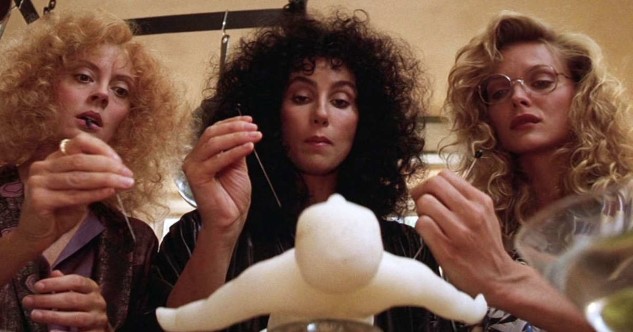
How witchcraft is depicted in film can seem highly contingent upon when and where that film is set. Colonial America? Get ready for a horror show of paranoia and suspicion, à la The Crucible or The Witch. If it’s modern high society, on the other hand, there’s a certain sex appeal inherent to witchcraft—an offhand metaphor for hedonistic women able to get exactly what they want, à la The Craft or Practical Magic. The Witches of Eastwick falls into the latter camp, buoyed by a vampy sense of charm and four leads who perfectly captured the moment: Susan Sarandon, Michelle Pfeiffer and Cher as a trio of comely witches alternatingly seduced/hounded by that most rakish of Old Scratch portrayers, Jack Nicholson. As the antagonist, Nicholson delights in the Earth’s tactile pleasures, luxuriating in causing misfortune along the way. If witches have historically been portrayed as the consorts of the devil, The Witches of Eastwick simply modifies that trope into a more modern one—here, they’re badass, jilted lovers. If Nicholson had a devilish hearse, you can be sure they’d puncture the tires and key the paint. It’s a film that delights in petty, feel-good vengeance. —Jim Vorel
22. Eve’s Bayou (1997)
Director: Kasi Lemmons
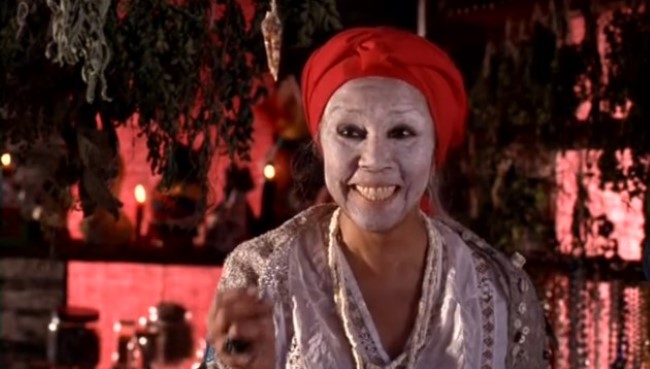
With slice-of-life in the ’hood films and romantic comedies being served in rapid succession in the late 1990s, Lemmon’s directorial debut is a tour-de-force flaked by outstanding performances from Jurnee Smollett, Debbi Morgan, Samuel L. Jackson and Lynn Whitfield. Smollett’s Eve Batiste experiences a chaotic and confusing summer of family revelations. Between her father’s profound infidelity and her older sister’s burgeoning womanhood, the 10-year-old begins relying on fortune telling and voodoo to right her family’s wrongs. But even though tragedy strikes the family in the end, there is a sense of rebirth for Eve and her sister. —Adreon Patterson
21. Witchfinder General (1968)
Director: Michael Reeves

Witchfinder General is one of those torture-centric horror films that caused a bonafide uproar in British society upon release, but would quickly seem (relatively) tame in the gonzo horror years to follow, especially in the U.S.A. Vincent Price stars in a role he always considered one of his finest performances, giving life to reviled witch-hunter Matthew Hopkins, who is estimated to have been responsible for the executions of 300 or more suspected witches in the mid-1600s. Unlike his earlier Edgar Allan Poe films of the ’60s, this is no campy performance in the vein of Roger Corman’s Tales of Terror or House of Usher. This is Price at his most stately, serious and sinister, embarking on a wave of brutal killings carried out in the name of religious conviction. It captures England during a period of unbridled mania and savagery. —Jim Vorel
20. Hagazussa: A Heathen’s Curse (2017)
Director: Lukas Feigelfeld
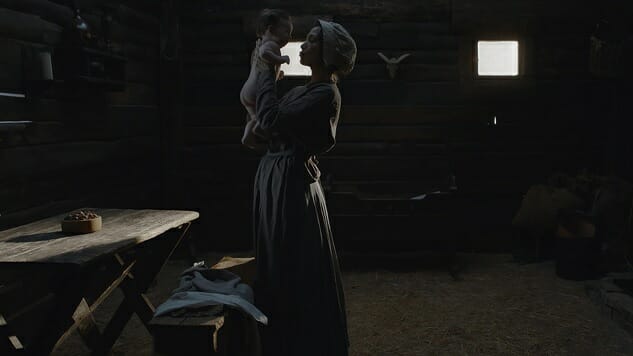
Content warning for people with misgivings about cannibalism, vomit, organ splatter, maggoty mushrooms, sexual assault and infinitely worse: Hagazussa provides a minefield of triggers. It’s gross. It’s also stunning, a hypnotic recreation of its time and its place: 15th century Europe, a land cast into the dark ages long before the advent of the age of reason. In between unsettling and barefaced displays of noxious human ills and pseudo hallucinatory insanity, rests still frames so gorgeous they belong in their own art gallery tableau. Snapshots of Austria’s countryside megacosm center on Albrun (Alexsandra Cwen), a woman orphaned as a girl and still alone as an adult, who spends a majority of her time trudging through and taking respite in the forests of her homeland. But Hagazussa’s idyllic appeal belies evil lurking in its frames, stalking Albrun like a basilisk, turning the woods she inhabits to stone. Albrun is marked from birth, doomed to alienation from and othering by her fellow man: As a child, depicted in the film’s opening chapter by Celina Peter, she and her mother, Martha (Claudia Martini), are harassed in dead of night by men disguised in fearsome horn-headed costumes, as concealing as they are intimidating. They’re infernally convinced Martha’s a witch. An hour and change later, the audience is given reason to wonder if they were right. To young Albrun, their incursions qualify as nightmares worse than those chronicled in fables. In the present day narrative, the prejudice of her youth follows her. She’s harassed by snotty village boys, then spared their taunts by a seemingly benevolent woman, Swinda (Tanja Petrovsky), then manipulated into serving Swinda’s own perverse ends. If Albrun isn’t a witch, society does a bang-up job giving her incentive to reconsider the calling. Hagazussa is further distinguished through a patina derived from David Lynch and Panos Cosmatos—slow, deliberate, perpetually unsettling. The film takes its time, but it drags the viewer along the way toward a mind-shattering oblivion. Are Albrun’s visions real, or figments of her imagination? Is witchery truly afoot, or is she just losing her marbles at the business end of ignorant mob persecution? The last of these is the only question with an emphatic “yes” answer, though the idea that the real monster here is Woman is pedantic bordering on boorish. Movies like this function because the monster exists, not simply because people historically treat outsiders like stray dogs at best, vermin at worst. —Andy Crump
19. The Craft (1996)
Director: Andrew Fleming
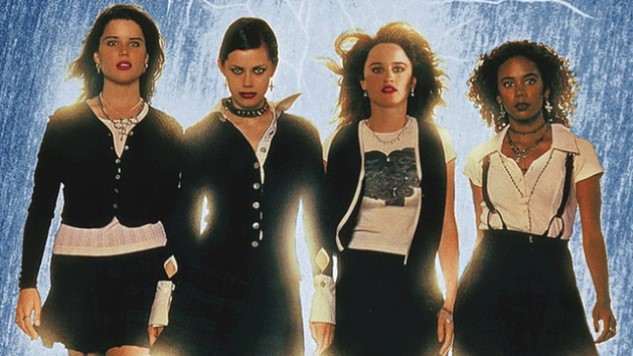
The Craft is one of those touchstones of ’90s, teen-friendly horror (see: I Know What You Did Last Summer) that has blossomed into the ranks of “cult films” in recent years, whether or not it really deserves the nostalgia. You can at least admire its deft evolution of John Hughes-era high school movie tropes, presenting an almost Mean Girls clique of girls with the added fun of witchcraft, although the inspiration might be more accurately attributed to the likes of Heathers. This film came along during that brief, odd period of the ’90s when “starring Fairuza Balk” was not an altogether weird thing to see on a movie poster, and it’s a better, quirkier film for it. We all know where the story is going, once these gals start dabbling in witchcraft for the causes of popularity and petty revenge—nobody gets away with being this bitchy in fiction. It’s hammy, and melodramatic, and protagonist Robin Tunney is easily the least interesting of her own clique, and yet The Craft is still oddly watchable today. It’s a well-preserved time capsule of a very specific moment in the twilight of the MTV Generation. —Jim Vorel
18. Witching & Bitching (2013)
Director: Álex de la Iglesia

What Shaun of the Dead did for zombies and What We Do in the Shadows did for vampires, Witching & Bitching essentially did for the cinematic depiction of witches, albeit on a less visible scale. Of the two comparisons, it’s Edgar Wright’s zom-com that rings more true of Iglesia’s Witching & Bitching, which is essentially a heist movie that takes a detour into cannibalistic witch country, with a side of absurdity. Full of solid performances from its Spanish cast, and infused with a quick wit and surprisingly gory streak, it’s a horror comedy that doesn’t skimp on splatter. You can’t quite take its witches seriously, but that won’t stop them from tying you to a spit and roasting you alive. —Jim Vorel
17. Snow White and the Seven Dwarfs (1937)
Director: David Hand
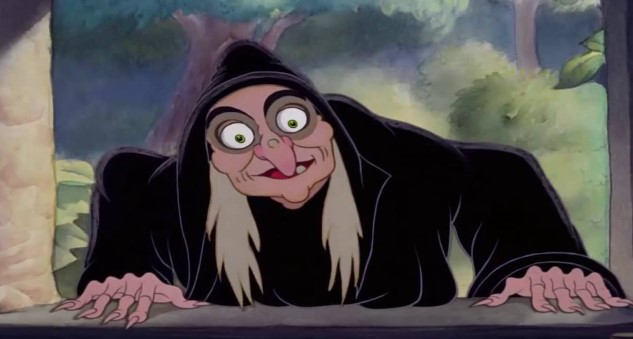
From the very beginning of the era of Disney animated feature films, witches have proven to be handy antagonists. Sleeping Beauty is one of the prime examples, but 22 years earlier, Snow White’s simplistic “Evil Queen” (whose actual name is apparently “Grimhilde”) laid the foundation for so many tropes to come. One gets the sense, watching this film today, that the animators wanted to depict the Queen as a classical, wart-nosed witch all along, but the film’s major plot device—that the queen is a desperate contender for “fairest of them all”—dictates that she can’t take on what might be considered her true form until she comes to Snow in disguise as a hunchbacked old crone. Her scheme to trick Snow into eating a poisoned apple seems appropriately biblical in nature, which only makes sense—given that witches were historically depicted as the consorts of Satan, the metaphor likely still resounded with those 1937 audiences. And indeed, the queen is eventually struck down by nothing short of a bolt of lightning, signifying the hand of God himself. This early in cinema history, you couldn’t exactly separate a witch from her scriptural damnation. —Jim Vorel
16. Kiki’s Delivery Service (1989)
Director: Hayao Miyazaki
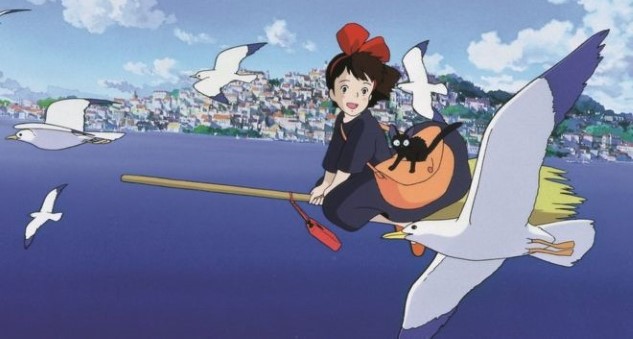
Based on Eiko Kadono’s popular 1985 young adult novel, Kiki’s Delivery Service is a cheerful and charming story of adolescent independence and growing up. Miyazaki’s fourth film under Studio Ghibli follows the titular Kiki, a 13-year-old witch who ventures out into the world from the comfort of her hometown for a year to begin her training as an adult. Noticeably lacking in any sort of antagonist or grand adventure, Kiki’s Delivery Service focuses instead on the everyday struggles of a young adult coming into her own, albeit with a magical twist. Finding a place to stay, securing a job, learning how to make new friends and taking on more responsibilities: these are the sort of stakes that define Kiki’s journey and make her story an endearing one. Miyazaki’s affinity for depicting flight shines through every scene of Kiki wrestling against the air current to steady her broom mid-flight, her dress billowing in the wind as she jets off in the film’s spectacular finale. Though all of Studio Ghibli’s previous films were modest critical if not financial successes up to this point, Kiki’s Delivery Service was a true watershed moment for the studio, becoming the highest-grossing film in Japan in 1989 and securing critical acclaim both at home and overseas. The film is a story of independence, positivity and the font of inner strength that compels every young person to go out into the world and build a life for his or herself. —Toussaint Egan
15. The Witches (1990)
Director: Nicolas Roeg
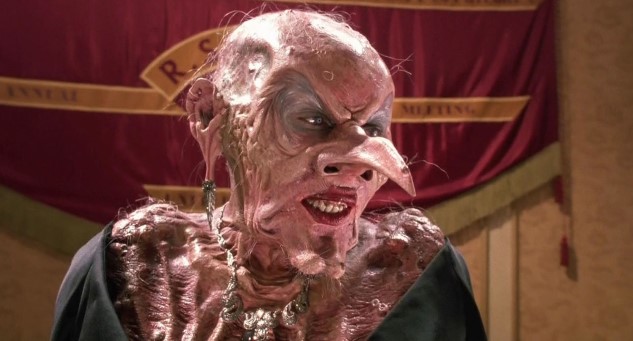
People have a tendency to somehow overlook the subversive, almost perverse nature of Roald Dahl’s sense of humor—you know, the guy who wrote George’s Marvelous Medicine, a book about a boy who tries to poison his grandmother—but it’s hard not to see it on display in The Witches, and particularly the film adaptation. This just happens to be one of the more macabre “kids movies” ever made, right up there in Return to Oz country. The grotesque, Jim Henson-conceived witch makeup is equal parts repulsive and goofy, and it’s hard not to feel uncomfortable watching the witches scratch madly at their open sores after removing their wigs. Make no mistake here, their goal is nothing short of the eradication of every single child on Earth, in ways both creative and cruel. In fact, once protagonist Luke is transformed into a mouse, the film becomes almost entirely a series of death-defying escapes—it’s like that harrowing Ratatouille sequence where Remy is almost roasted in an oven, except stretched out to feature length. Even that was ultimately not enough danger for Dahl, though, who objected to the film’s more upbeat ending, as opposed to the book’s rather devastating one. What a hardass. —Jim Vorel
14. The Love Witch (2016)
Director: Anna Biller

If you watch The Love Witch with no knowledge of its production or point of origin, you might assume it’s a lost gem of 1960s or 1970s supernatural filmmaking that’s only recently been recovered, restored and released to the public for niche consumption. This isn’t the case, of course, but nobody would fault your logic. Biller’s style is set in the bygone days of B-movie camp, though unlike similar faux-retro productions, à la 2012’s disingenuously nostalgic The Ghastly Love of Johnny X, there’s unabashed joy to her mimicry that reminds us how much fun the flicks The Love Witch emulates can be in spite of, or maybe because of, their badness. The film’s cheese factor is its single most obvious element next to Biller’s enthusiasm for kitsch and her emphasis on superb production design. Samantha Robinson’s ravishing (but equally deluded) witch in search of “true love” never stops to consider whether she has any idea of what those words truly mean, or what personal freedoms are okay to trample in the process. Unsurprisingly, there’s a horror element present in giving so much magical power to a person with such an infantile grasp of right and wrong—like the little boy in The Twilight Zone’s “It’s a Good Life,” you’d be wise not to upset her. —Andy Crump
13. The Little Mermaid (1989)
Directors: Ron Clements and John Musker
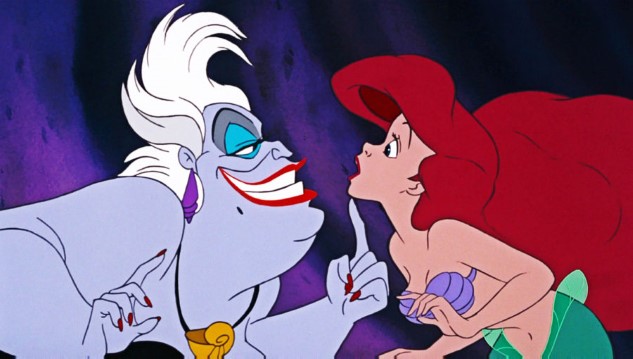
There’s no shortage of witchy adversaries in the depth of the Disney Vault, but Ursula is arguably the queen of them all. Certainly the “sea-witch” is integral to the plot of The Little Mermaid, and functions as the central node of the film’s bargain and “ticking clock” mechanic that Ariel must receive True Love’s Kiss within three days in order to avert catastrophe. She’s a witch in the truly arch sense of the stereotype—hanging out in an indisputably evil lair, ready to make Faustian deals with whomever might be unlucky enough to come along with an easily exploitable desire. She sings; she dances; she’s glam as hell—at least until growing into a giant kraken, in a finale that is genuinely more horrific than you probably remember. But that’s how you protect your head-witch-in-charge status. —Jim Vorel
12. You Won’t Be Alone (2022)
Director: Goran Stolevski
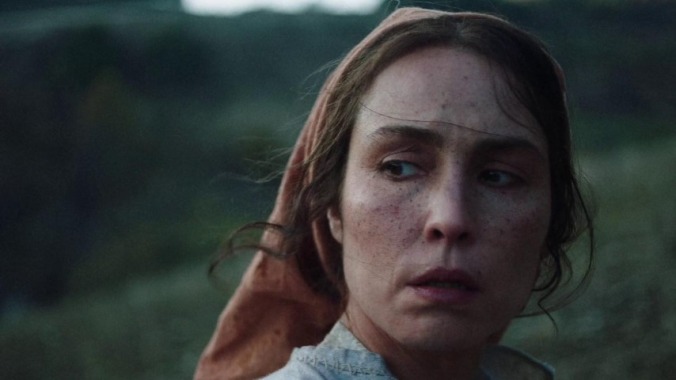
The sprawling, mountainous landscape of nineteenth century Macedonia envelops every frame of You Won’t Be Alone, writer-director Goran Stolevski’s feature debut. A meandering portrait of shape-shifting sorceresses who live on (and off of) the peripheral terrain of a pastoral village, the film is particularly interested in the shifting state of power and peril that comes with practicing witchcraft. Though its leisurely pace and sinuous storyline might test the audience’s patience, the Macedonian-Australian filmmaker packs his folk horror breakthrough with enough guts and gore to keep eyes fixed on the screen. When a mute baby girl is left by her mother in a cave to evade a seemingly inevitable indoctrination into witchcraft, she gradually grows into a feral young woman (Sara Klimoska). When a beldam “wolf-eatress” (Anamaria Marinca) eventually arrives to court her into the occult, the girl follows, cautiously curious about life outside of the cavern that sheltered her for the past 16 years. After being ritualistically branded with the witch’s mark, the girl realizes she possesses the ability to take on the form of any living creature she kills—coupled with a newfound appetite for hot blood and entrails. However, the girl’s swelling affinity for a world she had previously been cut off from clashes with the misanthropic outlook of her mother superior, resulting in the young witch going off on her own. In attempting to forge her own livelihood, the girl crosses paths with a young peasant woman (Noomi Rapace) and her newborn baby. Thinking the girl will do harm to her child, the mother lunges at her and is mortally wounded by the young witch’s talon-like nails. Arrested by fright and intrigue, the girl resolves to take this woman’s form for herself—a decision that sets forth a journey in understanding the intricacies of human life she might never have experienced otherwise. Though You Won’t Be Alone is entrenched in a hearty humanism that embraces the ordinary toil of staying alive, it is also steeped in observations of gendered strife as it has historically affected women. Before the young witch encounters Rapace’s peasant, the camera cuts to the woman clutching onto the wooden beams of a fence on her farm’s edge, crouching and caterwauling mid-labor. As soon as the baby is delivered, the midwife ushers the child away—and the blood-flecked woman waddles back to the working fields. Stolevski’s debut is enthralling and thoughtful, cutting through the clichés of similar recent releases of the same vein. Despite its under-interrogated premise, You Won’t Be Alone is an intriguing, unsettling feature debut with an incisive bite—a strength that the filmmaker will surely sharpen over time. The result is an enticing witch’s brew you can’t stop sipping, even if there’s a slightly sour aftertaste.–Natalia Keogan
11. Hocus Pocus (1993)
Director: Kenny Ortega
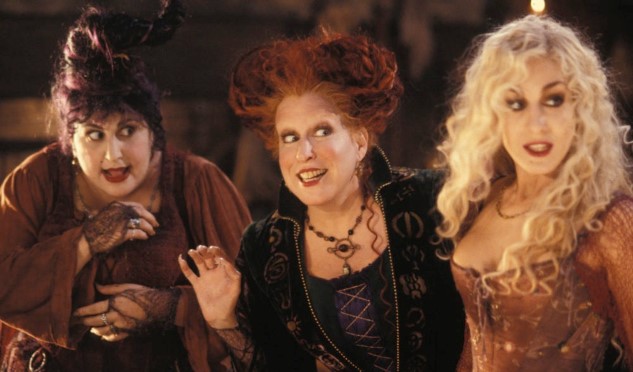
Hocus Pocus feels almost like a sister story at times to Roald Dahl’s The Witches—not quite as vicious, by any means, but its trio of Sanderson Sisters do still want to murder a bunch of kids, which is pretty hardcore as Disney goes. Largely ignored by both critics and audiences upon its initial release, the film proved to be one of those later bloomers that thrived in the nostalgic mind’s eye in the 2000s, when it became a cable Halloween season staple—the Halloween equivalent of It’s a Wonderful Life, if you will. The delightful viciousness of Bette Midler’s Winifred is a prime reason for why we’re still talking about the film today, as she found a way to combine her larger-than-life screen presence with a just a tinge of authentic menace. That the film simultaneously treats its witches as both antagonists and fish-out-of-water viewpoint characters serves to make them a loveable troupe of villains—how can you really hate these ladies after seeing them mistake an uncredited Garry Marshall for their demonic master? Thanks to the still-growing fervor for ’90s nostalgia, Hocus Pocus arguably feels more popular and relevant in 2019 than it ever has before. —Jim Vorel
10. Weapons (2025)
Director: Zach Cregger
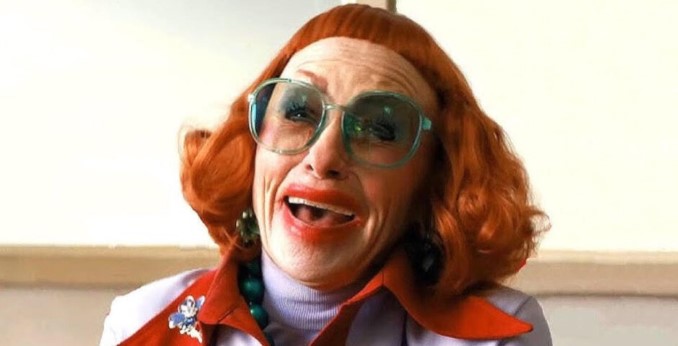
As Zach Cregger’s Weapons begins, we have no idea at all that its central mystery–why 17 grade school children all exited their homes one night and vanished into the night–has anything at all to do with the thought of witchcraft, though there’s an undeniable supernatural air to the eerie way they all mimic each other in their posture and running, arms straight out like they’re about to take wing and fly away. Of course, we eventually meet the entity responsible for the mass exodus, and suffice to say, it gets pretty witchy in short order. The woman–is she even human?–known as “Gladys” is played with horrifying zeal by Amy Madigan, like an alien doing the most poor job imaginable of blending in with an earthling population, even as she parasites entire communities to unnaturally extend her life. It’s clear why Gladys was eschewed from the marketing for Weapons–like the titular character of Oz Perkins’ Longlegs, the build-up to her big reveal, and the dissonant confusion between her appearance and her wicked actions, is striking. Suffice to say, this is witchcraft at its most debauched and misanthropic; she sees every person she encounters as just a blood bag to keep her going that little bit longer. The threat of a final, permanent death is the only thing that frightens this witch, and Weapons does not disappoint in bringing her story to a conclusion of glorious grand guignol. —Jim Vorel
9. Häxan, or Witchcraft Through the Ages (1922)
Director: Benjamin Christensen
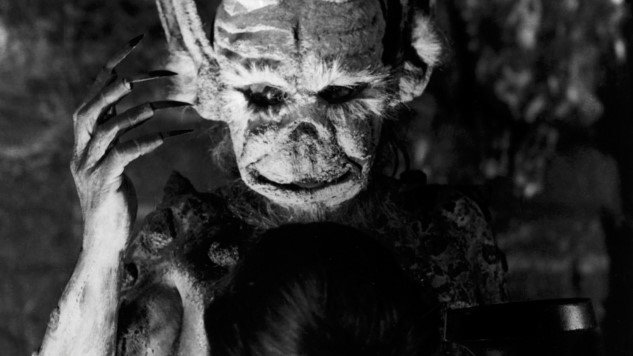
A truly unique silent film, Häxan is presented as a historical documentary and warning against hysteria, but in function it plays much more like a true horror film, especially considering the timeframe when it arrived in Danish and Swedish cinemas. Director Christensen based his depictions of witch trials on the real-life horrors codified in the Malleus Maleficarum, the 15th century “hammer of witches” used by clergy and inquisitors to persecute women and people with mental illness. The dreamlike—make that nightmarish—dramatization of these torture sequences were almost unthinkably extreme for the time, leading to the film being banned in the United States. But put simply: There’s imagery in Häxan that grabs hold of you and refuses to let go. Puffy-cheeked devils with long tongues lolling lazily out of their mouths. Naked men and women crawling and cavorting in circles of demons, lining up to literally kiss demonic asses. Scenes of torture straight out of Albrecht Dürer woodcuts or Divine Comedy illustrations. The grainy silence of black and white only makes Häxan more otherworldly to watch today—it feels like some kind of bleak Satanic relic that humankind was never supposed to witness. This is one silent film you won’t want on with children in the room. —Jim Vorel
8. Black Sunday (1960)
Director: Mario Bava
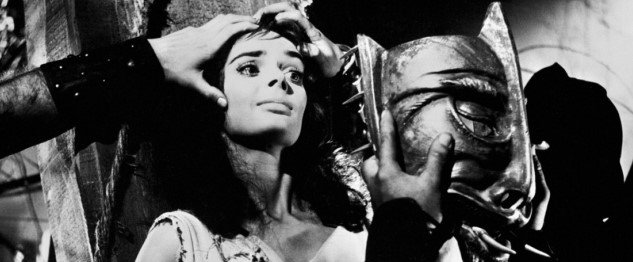
After years spent toiling as a cinematographer and (at times uncredited) co-director on an assortment of moderate to low-budget horror and sword-and-sandals productions, Mario Bava broke out in a big way with Black Sunday. Loosely (and I mean loosely) based on a short story by Nikolai Gogol, the film centers on the resurrection of a 17th century vampire-witch (Barbara Steele) and her paramour (Arturo Dominici) as they seek revenge on the descendants of the brother who executed her. Designed as a throwback to the Universal Monster movies of the 1930s, Black Sunday drew significant controversy for several gruesome sequences (including, but not limited to, the implementation of a spiked death mask and a moment where a cross is stabbed through an eye). Naturally, this kind of notoriety only intensified the film’s popularity. Though time has since lessened the impact of the gorier scenes, the movie still packs a huge punch with its nightmarish atmosphere, which is further accentuated by its vivid black-and-white photography and striking production design. An influence on filmmakers from Tim Burton to Francis Ford Coppola, Black Sunday remains a towering beast in the history of the horror genre. —Mark Rozeman
7. Rosemary’s Baby (1968)
Director: Roman Polanski
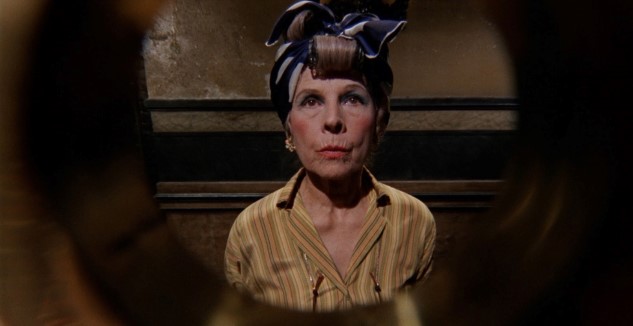
Rosemary’s Baby, horror classic though it undoubtedly is, may not be the first film one thinks of in a collection of “witch movies.” But what else does one call Ruth Gordon’s instantly iconic Minnie Castevet, if not a witch? This is a truly depraved soul in service of her dark master, but she comes to Rosemary in a guise that is chillingly mundane, that of the chatty next-door neighbor. Few films have done more to puncture that ’50s-era oversimplification of “neighborly” helpfulness than Rosemary’s Baby, nor done more to make an idealized past “when you didn’t have to lock your doors” seem more absurd. That’s all thanks to Gordon, whose inherent harmlessness, physical frailty, sashaying movements and staccato vocalization bely the steely composure we briefly see as Rosemary peers out at her unflappable face through the peephole. Gordon plays the character as one would in a stage play, overemphasizing her physical weakness and supposedly doddering mind, even as she plays a key role in stripping Mia Farrow’s Rosemary of all her agency and power to resist. Truly, of all the witches on this list, she’s one of the most calculating in her wickedness. —Jim Vorel
6. The Extended Potterverse
Directors: Various

J.K. Rowling’s modern reinvention of “witchcraft and wizardry” sought to, on some level, reclaim our knee-jerk, negative associations with the thought of “witches.” Rather than swell this list with 10 entries, including the most recent Fantastic Beasts franchise, we’ll instead consider them all as one—blockbuster, kid-friendly adventure films with individual highs (The Prisoner of Azkaban) and relative lows (The Chamber of Secrets). In particular, as far as classical female “witches” are concerned, the contribution of Rowling’s series was to imagine a world wherein the thought of magic was a bit less miraculous and a bit more practical, being ingrained organically into the fabric of everyday life. For Molly Weasley, magic is a helper that gets all the chores done in caring for an enormous clan of red-headed children. For Hermione, it’s a course of study, something to excel in academically and flex her raw intelligence. But of course, for some like Bellatrix Lestrange (or the bureaucratically malevolent Dolores Umbridge), magic is still a tool by which the user can dominate or destroy their enemies. There’s a great degree of freedom in the Potterverse as to what kind of witch one might choose to become, but you could say that the magical results tend to reflect that person’s inner character quite adroitly. —Jim Vorel
5. Howl’s Moving Castle (2004)
Director: Hayao Miyazaki

Howl’s Moving Castle was the Miyazaki film that almost didn’t happen. Conceived in 2001 amidst the height of Spirited Away’s success, Mamoru Hosoda was originally slated to direct the adaptation of Diana Wynne Jones’ 1986 novel before he and Ghibli had a falling out due to a conflict of creative visions. Miyazaki seized the reins and made the film his own, crafting the source material into a creative vessel through which he could forge his impassioned contempt for the then-ongoing U.S. invasion of Iraq into a parable about a fruitless magical proxy war between two nations in a steampunk fantasy setting. Howl’s is a whimsical if occasionally tepid adventure of a timid young woman who, after being cursed with the body of an old crone by a jealous witch, is rescued by a charismatic wizard who lives in a gigantic walking house. The film’s titular castle is one of Miyazaki’s finest creations, resembling a bow-legged fish armed with stumpy wings and turrets hobbling across the countryside and shuffling debris to and fro. To be sure, though its finale is a bit muted and the abrupt resolution of a love story in the movie’s denouement is a bit too neat and tidy, the film is a quintessential Miyazaki effort nonetheless that’s sure to please both newcomers and enthusiasts who might have somehow not seen it yet. —Toussaint Egan
4. The Wizard of Oz (1939)
Director: Victor Fleming

You can’t exactly put together a list of witch movies without the most iconic witch in the history of cinema, can you? Even during the years when The Wizard of Oz hadn’t quite claimed its modern classic status, it’s easy to see that the Wicked Witch of the West, as a character, had indelibly imprinted herself on the American psyche. The green face, the hooked nose, the pointed, warty chin—every physical characteristic of this particular witch, from her costume to her broomstick, became the standard template for pop culture witches in all the decades since. Only J.R.R. Tolkien can claim to have impacted the basic tropes of a genre (like the standard depiction of “orcs” and “dwarves”) in a way that is so fundamental and pervasive. Margaret Hamilton’s cackling, sumptuously evil performance as the gloating, aggrieved witch (they killed her sister!) rings with theatrical pomp. Surely there’s no more classic death scene than the witch being doused with a bucket of water, and then still having time to curse Dorothy a blue streak as she melts away—“Who would have thought a good little girl like you could destroy my beautiful wickedness!?!” —Jim Vorel
3. Spirited Away (2001)
Director: Hayao Miyazaki

What is it about Hayao Miyazaki’s Spirited Away that makes it one of his greatest—if not the greatest—films he has ever made? Perhaps it’s because the film represents the best expression of his most defining themes and concepts to date. The strength and perseverance of a young woman, the rapturous glory of flight, the spiritual struggle of personal and cultural amnesia with Japanese society, the redeeming power of love. Or maybe it has something to do with the crux of the film’s story being so archetypically identifiable, not so much a modern reimagining as it is a spiritual evocation of Lewis Carroll’s Alice in Wonderland, a childhood odyssey in a world that feels both familiar and foreign at the same time. Whatever the case, there is nothing quite like watching Spirited Away for the first time. The image of Chihiro, having discovered her parents transformed into pigs, running frantically through the streets as the town surrounding her comes to life as lights flicker into existence and spirits rise up from the earth is nothing short of magical. In the midst of all this—and serving as the prime mover for much of the action and threat—lies Yubaba, the other type of witch (as opposed to Kiki) Miyazaki has portrayed more than once in his movies, and she’s everything a menacing, yet complicated witch should be. —Toussaint Egan and Michael Burgin
2. Suspiria (1977)
Director: Dario Argento

Dario Argento’s 1977 Suspiria is the director’s best-loved movie, but it’s also his most atypical work. Unlike the rest of his peak-era filmography (its direct, uneven 1980 sequel Inferno excepted), it’s not strictly a giallo—the lurid murder mysteries Italian directors churned out in the mid-20th century—but instead an abstraction of the genre, removing the procedural narrative layer to replace it with pure aesthetic wonder. Plenty of giallo, like Mario Bava’s formative, drum-tight 1964 Blood and Black Lace, were gorgeous, but the occult-tinged Suspiria makes gorgeousness its primary concern. In that sense, in spirit, it’s closer to the gothic languor of French master Jean Rollin than any contemporary proto-slasher. From the film’s hypnotic opening sequence, which follows Suzy Banyon (Jessica Harper) as she takes a cab ride through a perfectly Grimm forest, the audience is bludgeoned with Goblin’s demented, baroque score and Luciano Tovoli’s phantasmagorical lensing. He and Argento used imbibition Technicolor film stock (unusual even in 1977) and innovative lighting techniques to achieve the film’s singular, Disney-inspired washes of red, yellow, blue and green—colors which become “the monster” of the film, a visible manifestation of the supernatural. Tellingly, when Suzy comes face-to-face with the film’s antagonist, the witch Helena Markos, Markos is invisible. Only her rattling, pained breathing marks her physical presence, but her insidious influence is everywhere, in every frame, drowning the world around her. Argento similarly corrupts the film’s formal structure: Goblin’s score wavers between diegetic and non-diegetic, while murder scenes become spiraling jump-cut departures from reality. Argento would go on to film sharper mysteries, and burrow further into self-reflexive madness, but Suspiria endures as his purest, most singular aesthetic statement. As such, it’s absolutely essential. —Astrid Budgor
1. The Witch (2016)
Director: Robert Eggers
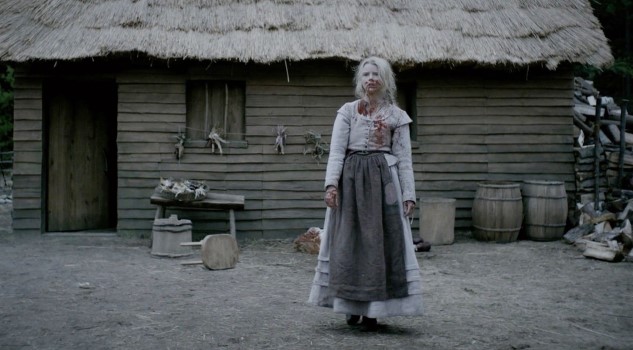
From its first moments, The Witch strands us in a hostile land. We watch (because that’s all we can do, helplessly) as puritan patriarch William (Ralph Ineson) argues stubbornly with a small council, thereby causing his family’s banishment from their “New England” community. We watch, and writer-director Robert Eggers holds our gaze while a score of strings and assorted prickly detritus. The wagon lurches ever-on into the wilderness, piling the frontier of this New World upon the literal frontier of an unexplored forest. It’s 1620, and William claims, “We will conquer this wilderness.” Eggers’ “New England Folk Tale” is a horror film swollen with the allure of the unknown. To say that it’s reminiscent of the Salem Witch Trials, which take place 70 years after the events in the film, would be an understatement—the inevitable consequences of such historic mania looms heavily over The Witch. All of this Eggers frames with a subconscious knack for creating tension within each shot, rarely relying on jump scares or gore, instead mounting suspense through one masterful edit after another. The effect, then, is that of a building fever dream in which primeval forces—lust, defiance, hunger, greed—simmer at the edges of experience, avoided but never quite conquered. —Dom Sinacola







































